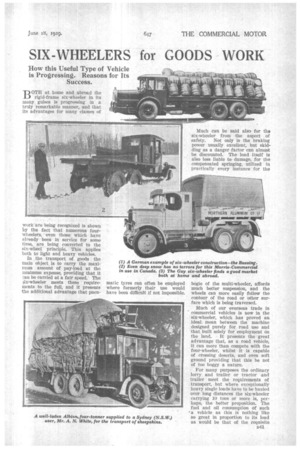SIX-WHEELERS for GOODS WORK
Page 119

Page 120

If you've noticed an error in this article please click here to report it so we can fix it.
BOTH at home and abroad the rigid-frame six-wheeler in its many guises is progressing in a truly remarkable manner, and that its advantages for many classes of
work: arebeing recognized is shown by the fact that numerous fourwheelers, even those which have already been in service for some time, are being converted to the six-wheel principle. This applies both to light and heavy vehicles.
In the transport of goods the main object is to carry the maximum amount of pay-load at the minimum expense, providing that it can be carried at a fair speed. The Ax-wheeler meets these requirements to the full, and it presents the additional advantage that pneu
matic tyres can often be employed where formerly their use would have been difficult if not impossible. Much can be said also for the six-wheeler from the aspect of safety. Not only is the braking power usually excellent, but skidding as a danger factor can almost be discounted. The load itself is also less liable to damage, for the compensated springing, utilized in practically every instance for the bogie of the multi-wheeler, affords much better suspension, and the wheels can more easily follow the contour of the road or other surface which is being traversed.
Much of our overseas trade in commercial vehicles is now in the six-wheeler, which has proved an ideal mean between the machine designed purely for road use and that built solely for employment on the land. It presents the great advantage that, as a road vehicle, It can more than compete with the four-wheeler, whilst it is capable of crossing deserts, and even soft ground providing that this be not of too boggy a nature.
For many purposes the ordinary lorry and trailer or tractor and trailer meet the requirements of transport, but where exceptionally heavy single loads have to be hauled over long distances the six-wheeler carrying 10 tons or more is, perhaps, the better proposition. The fuel and oil consumption of such a vehicle as this is nothing like so great in proportion to its load as would be that of the requisite number of four-wheeled machines for the same total burden.
There are now many excellent petrol and steam-propelled vehicles of this type on the market and a considerable number of conversion units, particularly for the lighter types. We believe that in the future the popularity of the principle will steadily increase, especially overseas.
The number of makers engaged in the production of the various models is steadily increasing. Elsewhere in this issue will ' be found comprehensive details of a new 10-tonner, and others are in production.
The initial trouble in many cases was a somewhat high cost, but as manufacture has continued and as the market has developed, prices have in most instances dropped to more reasonable levels.
It is obvious that a potential user of a road vehicle must consider the price as being so much per ton of permissible pay-load; it will then be found that there is no great disproportion; in fact, the biggercapacity machine will probably give greater value for the capital expenditure. Much of the efficiency of the multi-wheeler must, of course, depend upon whether full advantage can or cannot be taken of its load capacity. It does not pay to run any vehicle half laden, and this applies with even greater force
where the load capacity is so great ; running a 12-ton machine with a 6-ton load means a loss on transport cost of 6 tons of pay-load, whereas with a 4-tonner the half load only represents the figure for 2 tons.
It may be said that there are two schools of design in connection with this type of vehicle; one considers that driving on two wheels is quite sufficient, and the other that the drive should be taken through all four wheels of the rear bogie. We are not treating here
with the all-wheel-drive machine, as this is a special product and not one which is likely to be utilized to any considerable extent in this country—qt least for the transport of goods.
Where a vehicle is hot required to run on any other but good roads, then driving on two wheels only— even when the loads to be carried are so great as 10 tons—appears to be quite satisfactory, and there is, naturally,, a considerable saving in the cost of production, as the trailing axle—as it is usually termed in this form of construction —can be perfectly plain, although so far as the wheels are concerned it is advisable to equip these with brakes. Likewise, the arrangement of the suspension can be simplified, although, of course, provision must be made for taking the retardation stresses when brakes are employed on the trailing axle as well as on that through which the drive is taken. .
It is significant, however, that many of our bast-known makers are producingdpetrol and steam vehicles in which the drive is actually taken through all four wheels at the rear.








































































































































































































